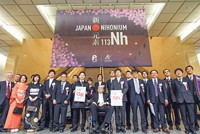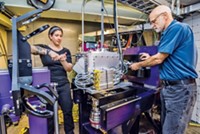Advertisement
Grab your lab coat. Let's get started
Welcome!
Welcome!
Create an account below to get 6 C&EN articles per month, receive newsletters and more - all free.
It seems this is your first time logging in online. Please enter the following information to continue.
As an ACS member you automatically get access to this site. All we need is few more details to create your reading experience.
Not you? Sign in with a different account.
Not you? Sign in with a different account.
ERROR 1
ERROR 1
ERROR 2
ERROR 2
ERROR 2
ERROR 2
ERROR 2
Password and Confirm password must match.
If you have an ACS member number, please enter it here so we can link this account to your membership. (optional)
ERROR 2
ACS values your privacy. By submitting your information, you are gaining access to C&EN and subscribing to our weekly newsletter. We use the information you provide to make your reading experience better, and we will never sell your data to third party members.
Physical Chemistry
The periodic table got four new elements
Nihonium, moscovium, tennessine, and oganesson complete the seventh row
by Jyllian Kemsley
December 14, 2016
| A version of this story appeared in
Volume 94, Issue 49
The periodic table rang in 2016 with a newly completed seventh row, after the International Union of Pure & Applied Chemistry formally recognized the discoveries of elements 113, 115, 117, and 118. A few weeks ago, the elements got their final names: nihonium, moscovium, tennessine, and oganesson, respectively.
The discoverers of new elements get to propose names and symbols. Japan’s RIKEN research institution named nihonium (Nh). Nihon is one of two ways to say “Japan” in Japanese.
European-American collaborations involving Russia’s Joint Institute for Nuclear Research and the U.S. Lawrence Livermore and Oak Ridge national laboratories named the other three elements. Moscovium (Mc) and tennessine (Ts) recognize the Moscow and Tennessee areas, respectively. Oganesson (Og) honors Russian nuclear physicist Yuri T. Oganessian, who leads the Flerov Laboratory of Nuclear Reactions at the Joint Institute for Nuclear Research.
What fascinates researchers about superheavy elements in the seventh row and beyond is their potential chemistry, says Dawn Shaughnessy, leader of the nuclear and radiochemistry group at Lawrence Livermore National Laboratory. As the number of protons in an atomic nucleus increases, electrons speed up and generate relativistic effects that alter orbital energy levels. That could mean that group reactivity trends don’t hold as elements get heavier. But to find out if that happens, chemists must first determine how to study the short-lived atoms, which are created one at a time in heavy-ion accelerators.
C&EN's YEAR IN REVIEW
Top Headlines of 2016
- Hawaii explosion cost a researcher an arm
- TSCA reform crossed the finish line
- U.S. elected Trump as president
- The periodic table got four new elements
- Post Dow-DuPont, chemical deal-making waned as 2016 advanced
- Labs made advances in Zika research
- Four ag giants to rule them all
- 2016 Nobel Prize in Chemistry at a glance
- Brexit bomb exploded
- Focus returned to Iran's chemical industry
- Overtime pay limit doubles under Obama administration
- The CRISPR craze continued
- Perfluorinated compounds got increased scrutiny
- From the lab to the market
- Paris Agreement to curb climate change took off
- World chemical production at a glance
- Flint's water woes lingered
- As China's economy slowed, chemical makers adjusted
- Mostafa A. El-Sayed won the 2016 Priestley Medal
- ACS members on average fared better than young graduates in employment surveys
- ACS invests internationally
- Spun-off firms found their footing in 2016
- Remembering the Nobel laureates we lost in 2016
- ACS proposed chemistry preprint server
- Berkeley College of Chemistry avoided reorganization
- Fight against opioid epidemic continued in 2016
- Noble gas shortages averted, for now
- The shale gas boom by the numbers
- Crop protection products in the crosshairs
- ACS launched new journals
- Website search terms of the year
- Biobased materials hit the big time
- No better deal emerged for Mossville, La.
- U.S. prepares for national food labeling standard
Top Research of 2016
- Mini factory made drugs on demand
- World's first PET-munching microbe discovered
- Liquid metals went to work
- Methylene activation reached new heights
- Biological structures of the year
- Wearable sensors were 'the' fashion accessories of 2016
- Scientists beefed up the antibiotic arsenal
- An enzymatic route to carbon-silicon bonds
- Single-atom catalysts gained a toehold
Revisiting Research of 2006






Join the conversation
Contact the reporter
Submit a Letter to the Editor for publication
Engage with us on Twitter